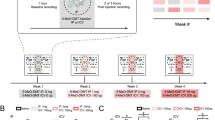Abstract
In free-moving male rats, the function relating frequency to the threshold current required to drive hippocampal rhythmical slow activity (RSA; “theta”) with septal stimulation has a minimum at 7.7 Hz. Classical anxiolytics all increase thresholds in the region of 7.7 Hz, and so does the novel anxiolytic buspirone. However, unlike classical anxiolytics, 2 or 3 weeks are normally required for the onset of the clinical effects of buspirone. This study tested the effects of long-term administration of chlordiazepoxide and buspirone on septal driving of RSA. Separate groups of naive rats received three IP injections per day of chlordiazepoxide (0.4 mg/kg), buspirone (0.1 mg/kg) or saline for 50 days. Both chlordiazepoxide and buspirone increased thresholds at 7.7 Hz, as expected. These acute effects were not significantly changed with chronic administration. Buspirone and chlordiazepoxide produced similar, statistically significant, but small cumulative reductions in thresholds at 6.9 Hz. The present experiments suggest that if the effects of anxiolytic drugs on septally driven RSA provide any basis for their clinical action, then classical anxiolytics may have two actions: an immediate effect on euphoria and tension and a delayed effect on anxiety proper — with buspirone sharing only the latter effect.
Similar content being viewed by others
References
Brucke F, Petsche H, Pillat B, Deisenhammer E (1959) Die Beeinflüssung der “Hippocampus-arousal-Reaktion” büeim Kaninchen durch electrische Reizung im Septum. Arch Exp Pathol Pharmakol (Pflügers Archiv) 269:319–338
Cohn JB, Rickels K (1989) A pooled, double-blind comparison of the effects of buspirone, diazepam and placebo in women with chronic anxiety. Curr Med Res Opin 11:304–320
Feihgner JP, Merideth CH, Hendrickson GA (1982) A double-blind comparison of buspirone and diazepam in outpatients with generalized anxiety disorder. J Clin Psychiatry (sect 2) 43:103–107
Gray JA (1982) The neuropsychology of anxiety. Oxford University Press, Oxford
Gray JA, Ball GG (1970) Frequency specific relation between hippocampal theta rhythm, behaviour and amobarbital action. Science 168:1246–1248
James DTD, McNaughton N, Rawlins JNP, Feldon J, Gray JA (1977) Septal driving of hippocampal theta rhythm as a function of frequency in the free-moving rat. Neuroscience 2:1007–1017
McNaughton N, James DTD, Stewart J, Gray JA, Valero I, Drewnowski A (1977) Septal driving of hippocampal theta rhythm as a function of frequency in the male rat: effects of drugs. Neuroscience 2:1019–1027
McNaughton N, Coop CF (1991) Neurochemically dissimilar anxiolytic drugs have common effects on hippocampal rhythmic slow activity. Neuropharmacology 30:855–863
Marc V, Morselli PL (1969) Effect of diazepam on plasma corticosterone levels in the rat. J Pharm Pharmacol 21:784–785
Matheson GK, Gage D, White G, Dixon V, Gipson D (1988) A comparison of the effects of buspirone and diazepam on plasma corticosterone levels in rat. Neuropharmacology 27:823–830
Quintero S, Mellanby J, Thompson MR, Nordeen H, Nutt D, McNaughton N, Gray JA (1985) Septal driving of hippocampal theta rhythm: role of gamma-aminobutyrate-benzodiazepine receptor complex in mediating effects of anxiolytics. Neuroscience 16:875–884
Riblet LA, Taylor DP, Eison MS, Stanto HC (1982) Pharmacology and neurochemistry of buspirone. J Clin Psychiatry 43:11–16
Schuckit MA (1984) Clinical studies of buspirone. Psychopathology (suppl 3) 17:61–68
Shephard RA (1986) Neurotransmitters, anxiety and benzodiazepines: a behavioural review. Neurosci Biobehav Rev 10:449–461
Snedecor GW, Cochran WG (1967) Statistical methods. Iowa State University Press, Iowa
Urban JH, Van De Kar LD, Lorens SA, Bethea CL (1986) Effect of the anxiolytic drug buspirone on prolactin and corticosterone secretion in stressed and unstressed rats. Pharmacol Biochem Behav 25:457–462
Valero I, Stewart J, McNaughton N, Gray JA (1977) Septal driving of hippocampal theta rhythm as a function of frequency in the male rat: effects of adreno-pituitary hormones. Neuroscience 2:1029–1032
Wheatley D (1982) Buspirone, multicenter efficacy study. J Clin Psychiatry (sect 2) 43:92–92
Zhu XO, McNaughton N (1991) Effects of long-term administration of anxiolytics on reticular-elicited hippocampal rhythmical slow activity. Neuropharmacology 30:1095–1099
Author information
Authors and Affiliations
Rights and permissions
About this article
Cite this article
Zhu, X., McNaughton, N. Minimal changes with long-term administration of anxiolytics on septal driving of hippocampal rhythmical slow activity. Psychopharmacology 118, 93–100 (1995). https://doi.org/10.1007/BF02245254
Received:
Revised:
Issue Date:
DOI: https://doi.org/10.1007/BF02245254




